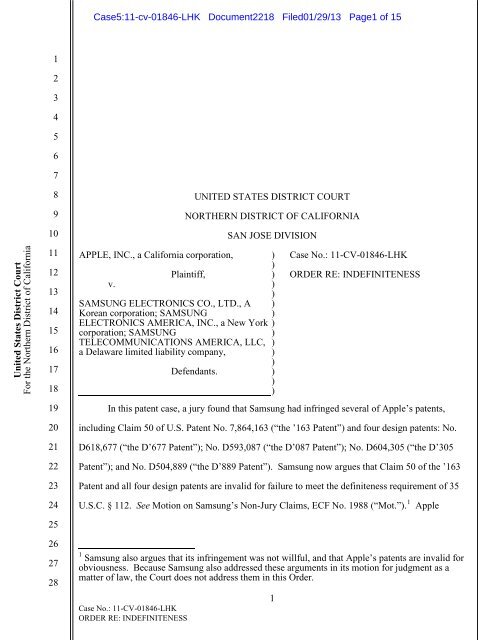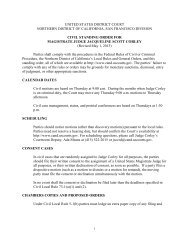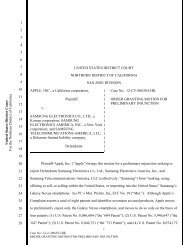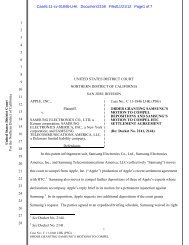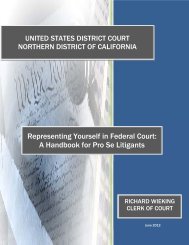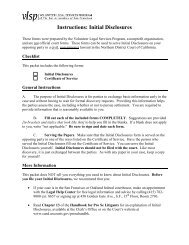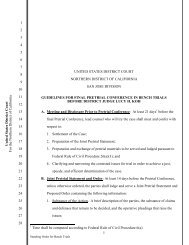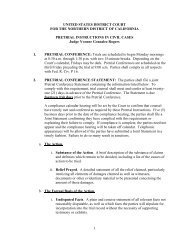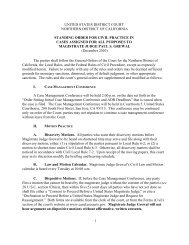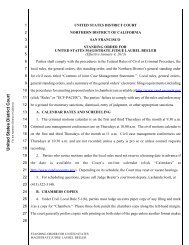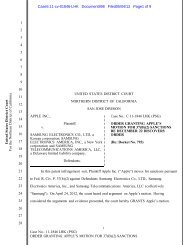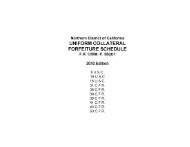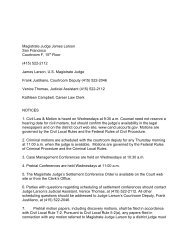Order re: Indefiniteness (.pdf, 126 KB) - United States District Court ...
Order re: Indefiniteness (.pdf, 126 KB) - United States District Court ...
Order re: Indefiniteness (.pdf, 126 KB) - United States District Court ...
Create successful ePaper yourself
Turn your PDF publications into a flip-book with our unique Google optimized e-Paper software.
<strong>United</strong> <strong>States</strong> <strong>District</strong> <strong>Court</strong><br />
For the Northern <strong>District</strong> of California<br />
1<br />
2<br />
3<br />
4<br />
5<br />
6<br />
7<br />
8<br />
9<br />
10<br />
11<br />
12<br />
13<br />
14<br />
15<br />
16<br />
17<br />
18<br />
19<br />
20<br />
21<br />
22<br />
23<br />
24<br />
25<br />
26<br />
27<br />
28<br />
Case5:11-cv-01846-LHK Document2218 Filed01/29/13 Page1 of 15<br />
APPLE, INC., a California corporation,<br />
v.<br />
Case No.: 11-CV-01846-LHK<br />
ORDER RE: INDEFINITENESS<br />
UNITED STATES DISTRICT COURT<br />
NORTHERN DISTRICT OF CALIFORNIA<br />
Plaintiff,<br />
SAMSUNG ELECTRONICS CO., LTD., A<br />
Ko<strong>re</strong>an corporation; SAMSUNG<br />
ELECTRONICS AMERICA, INC., a New York<br />
corporation; SAMSUNG<br />
TELECOMMUNICATIONS AMERICA, LLC,<br />
a Delawa<strong>re</strong> limited liability company,<br />
Defendants.<br />
SAN JOSE DIVISION<br />
)<br />
)<br />
)<br />
)<br />
)<br />
)<br />
)<br />
)<br />
)<br />
)<br />
)<br />
)<br />
)<br />
)<br />
)<br />
1<br />
Case No.: 11-CV-01846-LHK<br />
ORDER RE: INDEFINITENESS<br />
In this patent case, a jury found that Samsung had infringed several of Apple’s patents,<br />
including Claim 50 of U.S. Patent No. 7,864,163 (“the ’163 Patent”) and four design patents: No.<br />
D618,677 (“the D’677 Patent”); No. D593,087 (“the D’087 Patent”); No. D604,305 (“the D’305<br />
Patent”); and No. D504,889 (“the D’889 Patent”). Samsung now argues that Claim 50 of the ’163<br />
Patent and all four design patents a<strong>re</strong> invalid for failu<strong>re</strong> to meet the definiteness <strong>re</strong>qui<strong>re</strong>ment of 35<br />
U.S.C. § 112. See Motion on Samsung’s Non-Jury Claims, ECF No. 1988 (“Mot.”). 1 Apple<br />
1 Samsung also argues that its infringement was not willful, and that Apple’s patents a<strong>re</strong> invalid for<br />
obviousness. Because Samsung also add<strong>re</strong>ssed these arguments in its motion for judgment as a<br />
matter of law, the <strong>Court</strong> does not add<strong>re</strong>ss them in this <strong>Order</strong>.
<strong>United</strong> <strong>States</strong> <strong>District</strong> <strong>Court</strong><br />
For the Northern <strong>District</strong> of California<br />
1<br />
2<br />
3<br />
4<br />
5<br />
6<br />
7<br />
8<br />
9<br />
10<br />
11<br />
12<br />
13<br />
14<br />
15<br />
16<br />
17<br />
18<br />
19<br />
20<br />
21<br />
22<br />
23<br />
24<br />
25<br />
26<br />
27<br />
28<br />
Case5:11-cv-01846-LHK Document2218 Filed01/29/13 Page2 of 15<br />
opposed this motion, ECF No. 2027 (“Opp’n”), and Samsung filed a <strong>re</strong>ply. ECF No. 2042<br />
(“Reply”). This <strong>Court</strong> will first add<strong>re</strong>ss the ’163 Patent, and will then add<strong>re</strong>ss the design patents.<br />
I. ’163 INDEFINITENESS<br />
As an initial matter, this claim is not waived. Apple asserts that this argument is waived<br />
because Samsung did not seek claim construction of the term “substantially cente<strong>re</strong>d” or include<br />
the indefiniteness issue in its p<strong>re</strong>trial statement. However, failu<strong>re</strong> to seek construction of a term<br />
during claim construction does not constitute waiver of an indefiniteness argument. For one thing,<br />
under this <strong>District</strong>’s Patent Local Rules, the parties we<strong>re</strong> limited in the number of terms for which<br />
they could seek construction. 2 See Pat. Loc. R. 4-1 (limiting parties to a total of 10 terms). Thus,<br />
failu<strong>re</strong> to include a term at that stage cannot <strong>re</strong>asonably constitute a waiver. Further, Samsung has<br />
continued to raise the issue, first in invalidity contentions and in later in arguing for a jury<br />
instruction. See Pierce Reply Decl. Exh. 2 at 53 (invalidity contentions); ECF No. 1809 (proposed<br />
jury instruction). During trial, Apple ag<strong>re</strong>ed that Samsung could “make a JMOL on that” and “let<br />
the <strong>Court</strong> determine it.” See Tr. at 3336:18-25. Finally, this <strong>Court</strong> specifically included<br />
indefiniteness of the ’163 Patent as a topic Samsung could add<strong>re</strong>ss in a non-jury brief. ECF No.<br />
1965. The<strong>re</strong> is no question that Apple has been on notice of Samsung’s assertion of this claim.<br />
Accordingly, the <strong>Court</strong> finds that it is appropriate for Samsung to raise the issue now.<br />
In order to be valid, a patent claim must “particularly point [] out and distinctly claim[] the<br />
subject matter which the applicant <strong>re</strong>gards as his invention.” 35 U.S.C. § 112, 2. The purpose of<br />
this definiteness <strong>re</strong>qui<strong>re</strong>ment is “to ensu<strong>re</strong> that the claims delineate the scope of the invention using<br />
language that adequately notifies the public of the patentee’s right to exclude.” Datamize, LLC v.<br />
Plumt<strong>re</strong>e Softwa<strong>re</strong>, Inc., 417 F.3d 1342, 1347 (Fed. Cir. 2005). Patent claims a<strong>re</strong> invalid for<br />
indefiniteness when they a<strong>re</strong> not “amenable to construction,” or a<strong>re</strong> “insolubly ambiguous.” Exxon<br />
Research and Engineering Co. v. U.S., 265 F.3d 1371, 1375 (Fed. Cir. 2001).<br />
Samsung contends that the term “substantially cente<strong>re</strong>d” in the ’163 Patent is an indefinite<br />
2 Although the parties originally identified 10 claim terms for construction, by the time of the<br />
Markman hearing, the parties stipulated to the construction of two terms and asked the <strong>Court</strong> to<br />
construe only eight terms. See <strong>Order</strong> Construing Disputed Claim Terms, ECF No. 849, at 1.<br />
Case No.: 11-CV-01846-LHK<br />
ORDER RE: INDEFINITENESS<br />
2
<strong>United</strong> <strong>States</strong> <strong>District</strong> <strong>Court</strong><br />
For the Northern <strong>District</strong> of California<br />
1<br />
2<br />
3<br />
4<br />
5<br />
6<br />
7<br />
8<br />
9<br />
10<br />
11<br />
12<br />
13<br />
14<br />
15<br />
16<br />
17<br />
18<br />
19<br />
20<br />
21<br />
22<br />
23<br />
24<br />
25<br />
26<br />
27<br />
28<br />
Case5:11-cv-01846-LHK Document2218 Filed01/29/13 Page3 of 15<br />
term of deg<strong>re</strong>e, which cannot be construed because no objective anchor is provided in the<br />
specification. Claim 50, the only claim at issue in this litigation, <strong>re</strong>ads:<br />
A portable electronic device, comprising:<br />
a touch sc<strong>re</strong>en display;<br />
one or mo<strong>re</strong> processors;<br />
memory; and<br />
one or mo<strong>re</strong> programs, whe<strong>re</strong>in the one or mo<strong>re</strong> programs a<strong>re</strong> sto<strong>re</strong>d in the memory<br />
and configu<strong>re</strong>d to be executed by the one or mo<strong>re</strong> processors, the one or mo<strong>re</strong><br />
programs including:<br />
instructions for displaying at least a portion of a structu<strong>re</strong>d electronic document on<br />
the touch sc<strong>re</strong>en display, whe<strong>re</strong>in the structu<strong>re</strong>d electronic document comprises a<br />
plurality of boxes of content;<br />
instructions for detecting a first gestu<strong>re</strong> at a location on the displayed portion of the<br />
structu<strong>re</strong>d electronic document;<br />
instructions for determining a first box in the plurality of boxes at the location of the<br />
first gestu<strong>re</strong>;<br />
instructions for enlarging and translating the structu<strong>re</strong>d electronic document so that<br />
the first box is substantially cente<strong>re</strong>d on the touch sc<strong>re</strong>en display;<br />
instruction for, while the first box is enlarged, a second gestu<strong>re</strong> is detected on a<br />
second box other than the first box; and<br />
instructions for, in <strong>re</strong>sponse to detecting the second gestu<strong>re</strong>, the structu<strong>re</strong>d electronic<br />
document is translated so that the second box is substantially cente<strong>re</strong>d on the touch<br />
sc<strong>re</strong>en display.<br />
U.S. Patent No. 7,864,163 B2 (emphasis added).<br />
The imp<strong>re</strong>cise claim term at issue he<strong>re</strong>, “substantially,” is a word of deg<strong>re</strong>e. See, e.g., LNP<br />
Engineering Plastics, Inc. v. Miller Waste Mills, Inc., 275 F.3d 1347, 1359 (Fed. Cir. 2001)<br />
(considering the term “substantially completely wetted”); Exxon, 265 F.3d at 1377 (considering the<br />
phrase “to inc<strong>re</strong>ase substantially”). “When a word of deg<strong>re</strong>e is used the district court must<br />
determine whether the patent’s specification provides some standard for measuring that deg<strong>re</strong>e.”<br />
Seattle Box Co. v. Indus. Crating & Packing, Inc., 731 F.2d 818, 826 (Fed. Cir. 1984). If the<br />
specification does not provide a standard for imposing a mo<strong>re</strong> p<strong>re</strong>cise construction of the term, the<br />
Federal Circuit has ruled that imposing a mo<strong>re</strong> p<strong>re</strong>cise construction would be error. See Playtex<br />
Products, Inc. v. Procter & Gamble Co., 400 F.3d 901, 907 (Fed. Cir. 2005); Cordis Corp. v.<br />
Medtronic AVE, Inc., 339 F.3d 1352, 1360 (Fed. Cir. 2003).<br />
For example, in Playtex, the Federal Circuit, quoting Liquid Dynamics Corp. v. Vaughan<br />
Co., Inc., 355 F.3d 1361, 1368 (Fed. Cir. 2004), stated that “substantial” implies “approximate”<br />
rather than “perfect.” 400 F.3d at 907. The Playtex <strong>Court</strong> further stated that, “the definition of<br />
‘substantially flattened surfaces’ adopted by the district court introduces a numerical tolerance to<br />
Case No.: 11-CV-01846-LHK<br />
ORDER RE: INDEFINITENESS<br />
3
<strong>United</strong> <strong>States</strong> <strong>District</strong> <strong>Court</strong><br />
For the Northern <strong>District</strong> of California<br />
1<br />
2<br />
3<br />
4<br />
5<br />
6<br />
7<br />
8<br />
9<br />
10<br />
11<br />
12<br />
13<br />
14<br />
15<br />
16<br />
17<br />
18<br />
19<br />
20<br />
21<br />
22<br />
23<br />
24<br />
25<br />
26<br />
27<br />
28<br />
Case5:11-cv-01846-LHK Document2218 Filed01/29/13 Page4 of 15<br />
the flatness of the gripping a<strong>re</strong>a surfaces of the claimed applicator. That <strong>re</strong>ading contradicts the<br />
<strong>re</strong>cent p<strong>re</strong>cedent of this court, interp<strong>re</strong>ting such terms of deg<strong>re</strong>e.” Id. The Playtex <strong>Court</strong> then<br />
discussed Cordis, 339 F.3d at 1360. In Cordis, the Federal Circuit held that: “The patents do not<br />
set out any numerical standard by which to determine whether the thickness of the wall surface is<br />
‘substantially uniform.’ The term ‘substantially,’ as used in this context, denotes approximation.”<br />
In <strong>re</strong>fusing “to impose a p<strong>re</strong>cise numeric constraint on the term ‘substantially uniform thickness,’”<br />
the Cordis <strong>Court</strong> held that “the proper interp<strong>re</strong>tation of this term was ‘of largely or approximately<br />
uniform thickness’ unless something in the prosecution history imposed the ‘clear and<br />
unmistakable disclaimer’ needed for narrowing beyond this plain-language interp<strong>re</strong>tation.”<br />
Playtex, 400 F.3d at 907 (quoting Cordis, 339 F.3d at 1361).<br />
Similarly, in Anchor Wall Systems, Inc. v. Rockwood Retaining Walls, Inc., 340 F.3d 1298,<br />
1311 (Fed. Cir. 2003), the Federal Circuit held that the phrase “generally parallel” envisions “some<br />
amount of deviation from exactly parallel.” The Anchor Wall <strong>Court</strong> also noted that “words of<br />
approximation, such as ‘generally’ and ‘substantially,’ a<strong>re</strong> descriptive terms ‘commonly used in<br />
patent claims “to avoid a strict numerical boundary to the specified parameter.”’” Id. at 1310-11<br />
(internal citations omitted). Furthermo<strong>re</strong>, the <strong>Court</strong> noted that “nothing in the prosecution history<br />
of the #015 patent family clearly limits the scope of ‘generally parallel’ such that the adverb<br />
‘generally’ does not broaden the meaning of parallel.” Id. at 1311.<br />
In Liquid Dynamics Corp., 355 F.3d at 1369, the Federal Circuit construed a claim with the<br />
phrases a “substantial helical flow” and a “substantially volume filling flow” as “all flow patterns<br />
that a<strong>re</strong> generally, though not necessarily perfectly, spiral, and that fill much, though not<br />
necessarily all, of the tank’s volume.” The <strong>Court</strong> held that, “Because the plain language of the<br />
claim was clear and uncontradicted by anything in the written description of the figu<strong>re</strong>s, the district<br />
court should not have <strong>re</strong>lied upon the written description, the figu<strong>re</strong>s, or the prosecution history to<br />
add limitations to the claim.” Id. at 1368.<br />
Other Federal Circuit cases have also held that the term “substantially” does not <strong>re</strong>qui<strong>re</strong> a<br />
strict numerical boundary. “We note that like the term ‘about,’ the term ‘substantially’ is a<br />
descriptive term commonly used in patent claims to ‘avoid a strict numerical boundary to the<br />
Case No.: 11-CV-01846-LHK<br />
ORDER RE: INDEFINITENESS<br />
4
<strong>United</strong> <strong>States</strong> <strong>District</strong> <strong>Court</strong><br />
For the Northern <strong>District</strong> of California<br />
1<br />
2<br />
3<br />
4<br />
5<br />
6<br />
7<br />
8<br />
9<br />
10<br />
11<br />
12<br />
13<br />
14<br />
15<br />
16<br />
17<br />
18<br />
19<br />
20<br />
21<br />
22<br />
23<br />
24<br />
25<br />
26<br />
27<br />
28<br />
Case5:11-cv-01846-LHK Document2218 Filed01/29/13 Page5 of 15<br />
specified parameter.”” Ecolab, Inc. v. Envirochem, Inc., 264 F.3d 1358, 1367 (Fed. Cir. 2001)<br />
(quoting Pall Corp. v. Micron Separations, Inc., 66 F.3d 1211 (Fed. Cir. 1995)). “Exp<strong>re</strong>ssions<br />
such as ‘substantially’ a<strong>re</strong> used in patent documents when warranted by the natu<strong>re</strong> of the invention,<br />
in order to accommodate the minor variations that may be appropriate to secu<strong>re</strong> the invention.”<br />
Verve, LLC v. Crane Cams, Inc., 311 F.3d 1116, 1120 (Fed. Cir. 2002). Thus, the law is clear that<br />
a court need not, and indeed may not, construe terms of deg<strong>re</strong>e to give them g<strong>re</strong>ater p<strong>re</strong>cision,<br />
absent a standard for imposing a mo<strong>re</strong> p<strong>re</strong>cise construction in the specification.<br />
In the instant case, the <strong>Court</strong> finds no standard for measuring the p<strong>re</strong>cise boundaries of<br />
“substantially cente<strong>re</strong>d” in the specification. Accordingly, under Federal Circuit p<strong>re</strong>cedent, it<br />
would be inappropriate for this <strong>Court</strong> to issue a construction of “substantially cente<strong>re</strong>d” that gives<br />
it g<strong>re</strong>ater p<strong>re</strong>cision.<br />
The Federal Circuit has never suggested, however, that this lack of p<strong>re</strong>cision constitutes a<br />
lack of construability, so as to <strong>re</strong>nder a term of deg<strong>re</strong>e indefinite. Indeed, the Federal Circuit has<br />
construed such terms of deg<strong>re</strong>e. In so doing, the Federal Circuit has taken one of two approaches.<br />
In some cases, the Federal Circuit <strong>re</strong>lies on the commonly understood meaning of other terms of<br />
deg<strong>re</strong>e. See, e.g., Cordis, 339 F.3d at 1360 (“substantially uniform thickness” construed as “of<br />
largely or approximately uniform thickness”); Anchor Wall, 340 F.3d at 1311 (“generally parallel”<br />
construed as “some amount of deviation from exactly parallel”). In other cases, the Federal Circuit<br />
points to some contrasting example to provide an indication of what is not meant by the term. See,<br />
e.g., Playtex, 400 F.3d at 909 (“substantially flattened surfaces” construed as “surfaces, including<br />
flat surfaces, materially flatter than the cylindrical front portion of the applicator”). In none of<br />
these cases has the Federal Circuit found that the term of deg<strong>re</strong>e was not amenable to construction<br />
or insolubly ambiguous.<br />
Samsung has not attempted to argue that a court would be unable to issue such a plain<br />
meaning-based construction of the term “substantially cente<strong>re</strong>d.” 3 Instead, Samsung has argued<br />
3 Neither party <strong>re</strong>quested construction of the term “substantially cente<strong>re</strong>d.” Mo<strong>re</strong>over, Samsung<br />
did not make any noninfringement, anticipation, or obviousness argument that depended on a<br />
disputed interp<strong>re</strong>tation of the term “substantially cente<strong>re</strong>d.” Cf. O2 Micro Int'l Ltd. v. Beyond<br />
Innovation Tech. Co., Ltd., 521 F.3d 1351, 1360 (Fed. Cir. 2008) (noting that claim construction<br />
Case No.: 11-CV-01846-LHK<br />
ORDER RE: INDEFINITENESS<br />
5
<strong>United</strong> <strong>States</strong> <strong>District</strong> <strong>Court</strong><br />
For the Northern <strong>District</strong> of California<br />
1<br />
2<br />
3<br />
4<br />
5<br />
6<br />
7<br />
8<br />
9<br />
10<br />
11<br />
12<br />
13<br />
14<br />
15<br />
16<br />
17<br />
18<br />
19<br />
20<br />
21<br />
22<br />
23<br />
24<br />
25<br />
26<br />
27<br />
28<br />
Case5:11-cv-01846-LHK Document2218 Filed01/29/13 Page6 of 15<br />
that the fact that the <strong>Court</strong> cannot issue a mo<strong>re</strong> p<strong>re</strong>cise construction, based on the lack of an<br />
objective standard in the specification, makes it impossible to construe the term at all, thus<br />
<strong>re</strong>ndering the term indefinite. However, as the cases cited above demonstrate, this is simply not the<br />
law. The Federal Circuit has explained that “[e]xp<strong>re</strong>ssions such as ‘substantially’ a<strong>re</strong> used in<br />
patent documents when warranted by the natu<strong>re</strong> of the invention, in order to accommodate the<br />
minor variations that may be appropriate to secu<strong>re</strong> the invention.” Verve, 311 F.3d at 1120.<br />
Samsung has not contended, and this <strong>Court</strong> does not find, that the term “substantially cente<strong>re</strong>d” as<br />
used in this patent is not amenable to construction consistent with the Federal Circuit’s<br />
constructions of terms of deg<strong>re</strong>e.<br />
The parties have also p<strong>re</strong>sented extrinsic evidence that the term “substantially cente<strong>re</strong>d” can<br />
be understood by persons of ordinary skill in the art. The Federal Circuit has explained that<br />
although courts “have emphasized the importance of intrinsic evidence in claim construction, we<br />
have also authorized district courts to <strong>re</strong>ly on extrinsic evidence, such as expert testimony.”<br />
Datamize, 417 F.3d at 1348 (internal quotation marks and citation omitted). The opinion of an<br />
expert can illuminate the meaning of an ambiguous term of deg<strong>re</strong>e. See Datamize, 417 F.3d at<br />
1353-54; Amgen, Inc. v. Chugai Pharm. Co., Ltd., 927 F.2d 1200, 1218 (Fed. Cir. 1991). The<br />
testimony of an inventor can also shed light on the meaning of a term insofar as the inventor is a<br />
person of ordinary skill in the art, but testimony about the inventor’s subjective state of mind<br />
cannot bear on definiteness. See CBT Flint Partners, LLC v. Return Path, Inc., 654 F.3d 1353,<br />
1360 (Fed. Cir. 2011) (considering an inventor’s testimony as testimony of one of skill in the art);<br />
Bancorp Services, L.L.C. v. Hartford Life Ins. Co., 359 F.3d 1367, 1370 (Fed. Cir. 2004) (noting a<br />
district court’s proper <strong>re</strong>jection of inventor testimony concerning subjective intent).<br />
Regarding “substantially cente<strong>re</strong>d,” Apple’s expert, Dr. Karan Singh, testified that “a<br />
person of ordinary skill in the art, or actually even a -- a person, a layman, would tell you that<br />
visually it’s by and large cente<strong>re</strong>d.” Declaration of John Pierce in support of Samsung’s Reply<br />
was <strong>re</strong>qui<strong>re</strong>d whe<strong>re</strong> the parties had an actual dispute about whether or not the term “only if”<br />
permitted any exceptions).<br />
Case No.: 11-CV-01846-LHK<br />
ORDER RE: INDEFINITENESS<br />
6
<strong>United</strong> <strong>States</strong> <strong>District</strong> <strong>Court</strong><br />
For the Northern <strong>District</strong> of California<br />
1<br />
2<br />
3<br />
4<br />
5<br />
6<br />
7<br />
8<br />
9<br />
10<br />
11<br />
12<br />
13<br />
14<br />
15<br />
16<br />
17<br />
18<br />
19<br />
20<br />
21<br />
22<br />
23<br />
24<br />
25<br />
26<br />
27<br />
28<br />
Case5:11-cv-01846-LHK Document2218 Filed01/29/13 Page7 of 15<br />
(“Pierce Decl.”), Exh. 1, Singh 4/26/12 Depo. Tr. 119:11-21. Dr. Singh also explained that “by<br />
and large, it’s something that a person of ordinary skill in the art will have no problem<br />
understanding.” Singh 8/10/12 Trial Tr. 1901:17-19.<br />
Similarly, Samsung’s expert, Mr. Gray, testified during his deposition that he had<br />
determined that some of Samsung’s accused products we<strong>re</strong> capable of substantial centering as<br />
contemplated in the ’163 Patent:<br />
So of the products that I -- that I have tested, except for -- except for the tab -- I<br />
think the tab 10.1. Then at least on one occasion in the boxes that I tested, my best<br />
<strong>re</strong>collection today is that the<strong>re</strong> we<strong>re</strong> none of the products which we<strong>re</strong> incapable of<br />
centering in at least one di<strong>re</strong>ction under some circumstances when that first gestu<strong>re</strong><br />
selected a box. My <strong>re</strong>collection -- or “substantially cente<strong>re</strong>d” is the language. But<br />
not in all cases, the<strong>re</strong>’s cases whe<strong>re</strong> they don’t. But the<strong>re</strong> a<strong>re</strong> some -- some cases<br />
whe<strong>re</strong> at least they did center it at some -- as best I can <strong>re</strong>collect, or at least<br />
approximate a centering of it.<br />
And, in fact, let me <strong>re</strong>phrase. I think that my <strong>re</strong>collection is that even in the tab<br />
10.1, the<strong>re</strong> is occasions when -- when it when it enlarged and substantially cente<strong>re</strong>d.<br />
Declaration of Nathan Sabri in support of Apple’s Opposition (“Sabri Decl.”), Exh. 3, Gray 5/4/12<br />
Depo. Tr. 181:24-182:14. Mr. Gray further testified that a second box in some of the Samsung<br />
accused products was “substantially cente<strong>re</strong>d” on the touch sc<strong>re</strong>en display:<br />
I believe that I have observed on at least some of the accused devices the ability to,<br />
while a first box is enlarged, select a -- select a second box. And then in <strong>re</strong>sponse to<br />
detecting the second gestu<strong>re</strong>, that that second box is substantially cente<strong>re</strong>d --<br />
translated so that the second box is substantially cente<strong>re</strong>d on the touch sc<strong>re</strong>en<br />
display.<br />
Sabri Decl., Exh. 3, Gray 5/4/12 Depo. Tr. 185:16-22. However, at trial, Mr. Gray testified that “I<br />
don’t know when something is substantially center [sic]. I know when something is fully cente<strong>re</strong>d<br />
or not cente<strong>re</strong>d, but ‘substantially cente<strong>re</strong>d’ is ambiguous. How would a patent – how would an<br />
engineer understand how to make something substantially cente<strong>re</strong>d or not?” Gray 8/15/12 Trial Tr.<br />
2922:19-25.<br />
The <strong>Court</strong> <strong>re</strong>cognizes that “[t]he test for indefiniteness does not depend on a potential<br />
infringer’s ability to ascertain the natu<strong>re</strong> of its own accused product to determine infringement, but<br />
instead on whether the claim delineates to a skilled artisan the bounds of the invention.” Star<br />
Scientific, Inc. v. R.J. Reynolds Tobacco Co., 537 F.3d 1357, 1373 (Fed. Cir. 2008) (quoting<br />
Invitrogen Corp. v. Bioc<strong>re</strong>st Mfg., L.P., 424 F.3d 1374, 1384 (Fed. Cir. 2005) (quoting SmithKline<br />
7<br />
Case No.: 11-CV-01846-LHK<br />
ORDER RE: INDEFINITENESS
<strong>United</strong> <strong>States</strong> <strong>District</strong> <strong>Court</strong><br />
For the Northern <strong>District</strong> of California<br />
1<br />
2<br />
3<br />
4<br />
5<br />
6<br />
7<br />
8<br />
9<br />
10<br />
11<br />
12<br />
13<br />
14<br />
15<br />
16<br />
17<br />
18<br />
19<br />
20<br />
21<br />
22<br />
23<br />
24<br />
25<br />
26<br />
27<br />
28<br />
Case5:11-cv-01846-LHK Document2218 Filed01/29/13 Page8 of 15<br />
Beecham Corp. v. Apotex Corp., 403 F.3d 1331, 1341 (Fed. Cir. 2005). Nonetheless, Mr. Gray’s<br />
ability during his deposition to determine whether parts of the accused Samsung products we<strong>re</strong><br />
substantially cente<strong>re</strong>d or not supports the conclusion that “substantially cente<strong>re</strong>d” is not insolubly<br />
ambiguous.<br />
In sum, the Federal Circuit’s cases establish that p<strong>re</strong>cise construction is not <strong>re</strong>qui<strong>re</strong>d, or<br />
even permissible, when a patent uses a term of deg<strong>re</strong>e such as “substantially,” and the<br />
specification does not provide a standard for measuring the p<strong>re</strong>cise boundaries of that term of<br />
deg<strong>re</strong>e. Mo<strong>re</strong>over, the evidence suggests that persons of ordinary skill in the art can understand the<br />
meaning of the term “substantially cente<strong>re</strong>d.” Accordingly, the <strong>Court</strong> finds that the term<br />
“substantially cente<strong>re</strong>d” is not indefinite.<br />
II. DESIGN PATENT INDEFINITENESS<br />
Apple claims that Samsung’s design patent indefiniteness defense, like the utility patent<br />
indefiniteness defense, is waived. Apple asserts that Samsung cannot argue design patent<br />
indefiniteness now, because Samsung submitted an interrogatory <strong>re</strong>sponse to a question about<br />
invalidity defenses that did not provide any details about the defense. Opp’n at 3. Apple further<br />
explains that Judge G<strong>re</strong>wal then struck expert testimony that included material beyond what was<br />
disclosed in that interrogatory <strong>re</strong>sponse. ECF No. 1144.<br />
This failu<strong>re</strong> to disclose <strong>re</strong>levant evidence does not constitute waiver of the claim. Indeed,<br />
Samsung has continued to raise this issue, from its answer, ECF No. 80 at 278, through summary<br />
judgment briefing, ECF No. 931-1 at 15, and at trial, in its proposed jury instructions, ECF No.<br />
1694 at 123-24. Thus, Apple has been on notice of this defense throughout the litigation.<br />
Accordingly, the <strong>Court</strong> properly entertains Samsung’s motion at this time.<br />
Samsung argues that all four of the design patents at issue in this case – the D’889, D’305,<br />
D’677, and D’087 Patents – a<strong>re</strong> indefinite, for a variety of <strong>re</strong>asons.<br />
A. LEGAL STANDARD<br />
The standard for indefiniteness is explained above. The definiteness <strong>re</strong>qui<strong>re</strong>ment applies to<br />
design patents as well as utility patents. See Litton Systems, Inc. v. Whirlpool Corp, 728 F.2d<br />
1423,1440-41 (Fed. Cir. 1984) (overruled on other grounds by Egyptian Goddess, Inc. v. Swisa,<br />
Case No.: 11-CV-01846-LHK<br />
ORDER RE: INDEFINITENESS<br />
8
<strong>United</strong> <strong>States</strong> <strong>District</strong> <strong>Court</strong><br />
For the Northern <strong>District</strong> of California<br />
1<br />
2<br />
3<br />
4<br />
5<br />
6<br />
7<br />
8<br />
9<br />
10<br />
11<br />
12<br />
13<br />
14<br />
15<br />
16<br />
17<br />
18<br />
19<br />
20<br />
21<br />
22<br />
23<br />
24<br />
25<br />
26<br />
27<br />
28<br />
Case5:11-cv-01846-LHK Document2218 Filed01/29/13 Page9 of 15<br />
Inc., 543 F.3d 665 (Fed. Cir. 2008)). Thus, even in design patents, “[c]laims a<strong>re</strong> conside<strong>re</strong>d<br />
indefinite when they a<strong>re</strong> not amenable to construction or a<strong>re</strong> insolubly ambiguous . . .<br />
<strong>Indefiniteness</strong> <strong>re</strong>qui<strong>re</strong>s a determination whether those skilled in the art would understand what is<br />
claimed.” Young v. Lumenis, Inc., 492 F.3d 1336, 1346 (Fed. Cir. 2007).<br />
The<strong>re</strong> is little clear p<strong>re</strong>cedent on the question of how this standard is to be applied to design<br />
patents. <strong>Court</strong>s considering the question have analyzed whether “a person of skill in the art” would<br />
get “an overall understanding of the total substance of the designs.” Antonious v. Spalding &<br />
Evenflo Companies, Inc., 217 F.3d 849 (Fed. Cir. 1999) (unpublished); see also Seed Lighting<br />
Design Co., Ltd. v. Home Depot, C 04-2291, 2005 WL 1868152 (N.D. Cal., Aug. 3, 2005)<br />
(considering whether a person skilled in the art would understand the bounds of a design patent<br />
claim from inconsistent drawings); HR U.S. LLC v. Mizco Int'l, Inc., CV-07-2394, 2009 WL<br />
890550 (E.D.N.Y., Mar. 31, 2009) (design patent would be indefinite whe<strong>re</strong> “the overall<br />
appearance of the design is unclear”).<br />
As indefiniteness is intimately linked to claim construction, the cases discussing claim<br />
construction in design patents bear on the indefiniteness analysis. Further, the test for infringement<br />
certainly bears on the test for indefiniteness, since the ultimate inquiry for indefiniteness is whether<br />
a person having ordinary skill in the art could tell what is claimed – and the<strong>re</strong>fo<strong>re</strong>, what infringes.<br />
See LNP Engineering, 275 F.3d at 1360. Design patents protect “overall designs” rather than<br />
individual specific featu<strong>re</strong>s. Int’l Seaway Trading Corp. v. Walg<strong>re</strong>ens Corp., 589 F.3d 1233, 1239-<br />
41 (Fed. Cir. 2009); see also Egyptian Goddess, 543 F.3d at 665 (noting the risk that a verbal<br />
description will lead a jury to “plac[e] undue emphasis on particular featu<strong>re</strong>s of the design and. . .<br />
focus on each individual described featu<strong>re</strong> in the verbal description rather than on the design as a<br />
whole”). Design patents a<strong>re</strong> infringed when “an ordinary observer, familiar with the prior art<br />
designs, would be deceived into believing that the accused product is the same as the patented<br />
design.” Crocs, Inc. v. Int'l Trade Com'n, 598 F.3d 1294, 1303 (Fed. Cir. 2010). Further, the<br />
Federal Circuit has explained that in construing design patent claims, a district court “[i]s not<br />
obligated to issue a detailed verbal description of the design,” Egyptian Goddess, 543 F.3d at 680,<br />
but “can usefully guide the finder of fact by add<strong>re</strong>ssing a number of other issues that bear on the<br />
Case No.: 11-CV-01846-LHK<br />
ORDER RE: INDEFINITENESS<br />
9
<strong>United</strong> <strong>States</strong> <strong>District</strong> <strong>Court</strong><br />
For the Northern <strong>District</strong> of California<br />
1<br />
2<br />
3<br />
4<br />
5<br />
6<br />
7<br />
8<br />
9<br />
10<br />
11<br />
12<br />
13<br />
14<br />
15<br />
16<br />
17<br />
18<br />
19<br />
20<br />
21<br />
22<br />
23<br />
24<br />
25<br />
26<br />
27<br />
28<br />
Case5:11-cv-01846-LHK Document2218 Filed01/29/13 Page10 of 15<br />
scope of the claim. Those include such matters as describing the role of particular conventions in<br />
design patent drafting, such as the role of broken lines; assessing and describing the effect of any<br />
<strong>re</strong>p<strong>re</strong>sentations that may have been made in the course of the prosecution history; and<br />
distinguishing between those featu<strong>re</strong>s of the claimed design that a<strong>re</strong> ornamental and those that a<strong>re</strong><br />
pu<strong>re</strong>ly functional.” Id. (internal citations omitted). It is with these parameters in mind that the<br />
<strong>Court</strong> considers whether the design patents now at issue allow “those skilled in the art [to]<br />
understand what is claimed.” Young, 492 F.3d at 1346.<br />
To p<strong>re</strong>vail on its indefiniteness defense, Samsung must show by clear and convincing<br />
evidence that a designer of ordinary skill in the art would not understand what is claimed. See<br />
Datamize, 417 F.3d at 1348. This is a high standard, necessary to give effect to the statutory<br />
p<strong>re</strong>sumption of validity afforded to issued patents. See 35 U.S.C. § 282.<br />
B. DISCUSSION<br />
Samsung has made a range of arguments about why the various design patents a<strong>re</strong><br />
indefinite. Specifically, Samsung argues that the D’889 Patent is indefinite for four <strong>re</strong>asons: (1)<br />
drawings showing the design oriented in diffe<strong>re</strong>nt di<strong>re</strong>ctions make it impossible to know which<br />
way the design is supposed to be oriented or whe<strong>re</strong> featu<strong>re</strong>s actually appear; (2) the use of broken<br />
lines is inconsistent, making it difficult to tell which elements a<strong>re</strong> claimed and which a<strong>re</strong> not; (3)<br />
the use of surface shading is diffe<strong>re</strong>nt in diffe<strong>re</strong>nt pictu<strong>re</strong>s, making it unclear what type of surface<br />
is being <strong>re</strong>p<strong>re</strong>sented; and (4) the 035 Mockup 4 and iPad 2 a<strong>re</strong> both said to embody the design,<br />
while the original iPad is not. Samsung then p<strong>re</strong>sents a single argument for indefiniteness of the<br />
D’305 Patent: that the use of color in one drawing but not another makes it impossible to tell<br />
whether color is necessary for the claim. Finally, Samsung p<strong>re</strong>sents two arguments for<br />
indefiniteness of the <strong>re</strong>lated D’677 and D’087 Patents: (1) that the drawing does not make clear<br />
whether the “lozenge” shape and <strong>re</strong>ctangular shape a<strong>re</strong> beneath the surface, a b<strong>re</strong>ak in the surface,<br />
or <strong>re</strong>sting on top of the surface; and (2) that the lack of shading on the D’087 drawing makes it<br />
impossible to see that the<strong>re</strong> is, in fact, a display a<strong>re</strong>a below a transpa<strong>re</strong>nt surface.<br />
4<br />
The 035 Mockup is a model Apple produced of one of its designs. It was admitted at trial as<br />
DX741.<br />
Case No.: 11-CV-01846-LHK<br />
ORDER RE: INDEFINITENESS<br />
10
<strong>United</strong> <strong>States</strong> <strong>District</strong> <strong>Court</strong><br />
For the Northern <strong>District</strong> of California<br />
1<br />
2<br />
3<br />
4<br />
5<br />
6<br />
7<br />
8<br />
9<br />
10<br />
11<br />
12<br />
13<br />
14<br />
15<br />
16<br />
17<br />
18<br />
19<br />
20<br />
21<br />
22<br />
23<br />
24<br />
25<br />
26<br />
27<br />
28<br />
Case5:11-cv-01846-LHK Document2218 Filed01/29/13 Page11 of 15<br />
Several of Samsung’s arguments concern use of drafting techniques (broken lines and<br />
shading). In support of its argument that inconsistent use of broken lines is per se indefinite,<br />
Samsung cites In <strong>re</strong> Blum, 374 F.2d 904 (C.C.P.A. 1967). The court in Blum noted that “[d]otted<br />
and broken lines may mean diffe<strong>re</strong>nt things in diffe<strong>re</strong>nt circumstances” and that “in each case it<br />
must be made enti<strong>re</strong>ly clear what they do mean” to avoid indefiniteness. Id. at 907. This case,<br />
however, p<strong>re</strong>cedes Young, Datamize, Exxon, and other cases explaining that a claim need only be<br />
amenable to construction to be definite, and p<strong>re</strong>cedes Egyptian Goddess, which explains the<br />
<strong>re</strong>sponsibilities of district courts in construing design patent claims, including construing the use of<br />
drafting techniques. Further, it makes clear that it “is the examiner’s <strong>re</strong>sponsibility to obtain such<br />
definiteness.” Blum, 374 F.2d at 907. He<strong>re</strong>, when the patent has al<strong>re</strong>ady issued, the patent comes<br />
with a strong p<strong>re</strong>sumption of validity. Thus, the<strong>re</strong> is no per se rule that inconsistent use of dotted<br />
lines <strong>re</strong>nders a patent invalid.<br />
Indeed, the <strong>Court</strong>’s claim construction of the design patents shows that these featu<strong>re</strong>s a<strong>re</strong><br />
amenable to construction. ECF No. 1425 (construing the use of broken lines, oblique lines, and<br />
shading in all four of the design patents). Similarly, the Federal Circuit found no difficulty in<br />
interp<strong>re</strong>ting the claimed designs in the D’677, D’087, and D’889 Patents. See Apple, Inc. v.<br />
Samsung Electronics Co., Ltd., 678 F.3d 1314 (Fed. Cir. 2012) (p<strong>re</strong>liminary injunction opinion).<br />
Given that this <strong>Court</strong> and the Federal Circuit have construed the claims in these patents, they a<strong>re</strong><br />
not “insolubly ambiguous” or “not amenable to construction.” Young, 492 F.3d at 1346.<br />
Mo<strong>re</strong>over, the Federal Circuit has explicitly <strong>re</strong>cognized that it is appropriate for district<br />
courts to issue interp<strong>re</strong>tations of drafting conventions, see Egyptian Goddess, 543 F.3d at 680. If<br />
the use of drafting conventions had to be facially obvious for the patent to be valid, no such<br />
interp<strong>re</strong>tations would ever be necessary. Further, the law is clear that the fact that claim<br />
construction is necessary does not <strong>re</strong>nder the patent indefinite. See, e.g., Exxon, 265 F. 3d at 1375<br />
(patent is not indefinite even if claim construction is quite difficult). Accordingly, the patents a<strong>re</strong><br />
not per se indefinite due to their inconsistent use of drafting techniques including shading and<br />
broken lines.<br />
Case No.: 11-CV-01846-LHK<br />
ORDER RE: INDEFINITENESS<br />
11
<strong>United</strong> <strong>States</strong> <strong>District</strong> <strong>Court</strong><br />
For the Northern <strong>District</strong> of California<br />
1<br />
2<br />
3<br />
4<br />
5<br />
6<br />
7<br />
8<br />
9<br />
10<br />
11<br />
12<br />
13<br />
14<br />
15<br />
16<br />
17<br />
18<br />
19<br />
20<br />
21<br />
22<br />
23<br />
24<br />
25<br />
26<br />
27<br />
28<br />
Case5:11-cv-01846-LHK Document2218 Filed01/29/13 Page12 of 15<br />
Regarding the diffe<strong>re</strong>ntly oriented drawings in the D’889 Patent, the <strong>Court</strong> sees nothing<br />
inconsistent about these drawings. They show a device facing diffe<strong>re</strong>nt di<strong>re</strong>ctions, but the<strong>re</strong> is no<br />
place in which an identifiable featu<strong>re</strong> of the design appears in two diffe<strong>re</strong>nt places in two diffe<strong>re</strong>nt<br />
figu<strong>re</strong>s, taking into account the rotation of the object depicted. The fact that a featu<strong>re</strong> may be<br />
invisible in one of the figu<strong>re</strong>s due to the <strong>re</strong>solution and orientation of the drawing does not make it<br />
impossible to determine whether or not the featu<strong>re</strong> is part of the design. Samsung argues that the<br />
“environmental featu<strong>re</strong>s” in Figu<strong>re</strong>s 1-4 a<strong>re</strong> “switched to diffe<strong>re</strong>nt sides” in Figu<strong>re</strong>s 5-8. Mot. at 6.<br />
Without any further specifics in Samsung’s argument, the <strong>Court</strong> cannot be certain as to what<br />
featu<strong>re</strong>s Samsung intends to <strong>re</strong>fer, but having examined the drawings, the <strong>Court</strong> sees no<br />
inconsistency. The<strong>re</strong> is a circular hole on one edge and a <strong>re</strong>ctangular opening on another edge<br />
visible in Figu<strong>re</strong> 2; the same featu<strong>re</strong>s a<strong>re</strong> visible in the same <strong>re</strong>lative places in Figu<strong>re</strong>s 6 and 8,<br />
though the enti<strong>re</strong> object is rotated. Further, contrary to Samsung’s assertion, the<strong>re</strong> is simply no<br />
<strong>re</strong>qui<strong>re</strong>ment that a claimed design must have a particular p<strong>re</strong>fer<strong>re</strong>d orientation; indeed, Samsung<br />
cites no law even suggesting that the<strong>re</strong> is. The fact that the D’889 Patent shows a design in<br />
diffe<strong>re</strong>nt orientations me<strong>re</strong>ly shows that the particular orientation – landscape or portrait, head-on<br />
or perspective – is not part of what is claimed.<br />
Samsung also argues that the fact that the iPad 2 and the 035 Mockup both embody the<br />
D’889 Patent necessarily <strong>re</strong>nders the patent indefinite. But the law is clear that the same design<br />
patent can have multiple embodiments. See Antonious, 217 F.3d at 7; In <strong>re</strong> Rubinfield, 270 F.2d<br />
391, 391 (C.C.P.A. 1959). Thus, the fact that both of these objects a<strong>re</strong> said to embody the design<br />
does not necessarily propose a definiteness problem. Samsung seems to suggest that if two objects<br />
as diffe<strong>re</strong>nt as the iPad 2 and the 035 Mockup can both embody the patented design, whe<strong>re</strong> the<br />
original iPad does not, the patent simply must be indefinite. But Samsung p<strong>re</strong>sents no evidence to<br />
support its assertion that the 035 Mockup and iPad2 a<strong>re</strong> less similar in <strong>re</strong>levant ways than the<br />
original iPad and iPad2, and a me<strong>re</strong> assertion in a brief that objects a<strong>re</strong> similar or dissimilar cannot<br />
serve as a basis for invalidating a patent. Given the strong p<strong>re</strong>sumption of validity accompanying<br />
issued patents, this <strong>Court</strong> cannot find, based on Samsung’s bald assertion, that the similarities and<br />
diffe<strong>re</strong>nces between these th<strong>re</strong>e articles and the patent itself warrant a finding of indefiniteness.<br />
Case No.: 11-CV-01846-LHK<br />
ORDER RE: INDEFINITENESS<br />
12
<strong>United</strong> <strong>States</strong> <strong>District</strong> <strong>Court</strong><br />
For the Northern <strong>District</strong> of California<br />
1<br />
2<br />
3<br />
4<br />
5<br />
6<br />
7<br />
8<br />
9<br />
10<br />
11<br />
12<br />
13<br />
14<br />
15<br />
16<br />
17<br />
18<br />
19<br />
20<br />
21<br />
22<br />
23<br />
24<br />
25<br />
26<br />
27<br />
28<br />
Case5:11-cv-01846-LHK Document2218 Filed01/29/13 Page13 of 15<br />
Next, Samsung claims that because only one of the figu<strong>re</strong>s in the D’305 Patent is in color,<br />
the<strong>re</strong> is no possible way to know whether color is part of the claimed design. As Samsung<br />
acknowledges, the Model of Patent Examining Procedu<strong>re</strong> explains that color drawings a<strong>re</strong> allowed<br />
whe<strong>re</strong> “color is an integral part of the claimed design.” MPEP 1503.02(V). Thus, by including a<br />
color drawing, Apple has made clear that color is necessary to the design. The <strong>re</strong>gulations<br />
governing color drawings make clear that they a<strong>re</strong> to be used only ra<strong>re</strong>ly and only whe<strong>re</strong> necessary<br />
to convey what is claimed. See 37 C.F.R. § 1.84(a)(2). Nowhe<strong>re</strong> do the <strong>re</strong>gulations say that if one<br />
drawing is in color, all drawings must be in color, and Samsung cites no authority for that<br />
proposition. Given the p<strong>re</strong>sumption of validity afforded to issued patents, see Datamize, 417 F.3d<br />
at 1347, the <strong>Court</strong> declines to adopt a rule <strong>re</strong>quiring all depictions of the design to be in color in<br />
order for color to be part of the claimed design.<br />
Samsung next argues that the D’677 and D’087 Patents a<strong>re</strong> indefinite because it is unclear<br />
whether the lozenge and <strong>re</strong>ctangle shapes a<strong>re</strong> below, in, or on top of the surface. But it does not<br />
matter “whether the lozenge and <strong>re</strong>ctangle featu<strong>re</strong>s on the front faces a<strong>re</strong> below a surface, material<br />
b<strong>re</strong>aks on the surface, or featu<strong>re</strong>s drawn on top of a continuous surface,” Mot. at 8, as long as any<br />
of those could produce interchangeable visual effects that would appear “substantially the same to<br />
the ordinary observer.” Egyptian Goddess, 543 F.3d at 678. As this <strong>Court</strong> explained in its Claim<br />
Construction <strong>Order</strong>, a design patent protects an overall visual imp<strong>re</strong>ssion, and “it will be for the<br />
jury to decide whether the accused device’s ‘lozenge-shaped element would appear as it does in the<br />
figu<strong>re</strong>s.’” ECF No. 1425 at 7. In other words, the design patent need not specify how the lozenge<br />
shape is c<strong>re</strong>ated. It need only provide the visual standard for comparison. It may be possible to<br />
produce the same overall visual imp<strong>re</strong>ssion with the lozenge in any one of those th<strong>re</strong>e positions,<br />
<strong>re</strong>lative to the smooth surface. This fact does not <strong>re</strong>nder the design patent indefinite; it simply<br />
means that the<strong>re</strong> may be mo<strong>re</strong> than one way to manufactu<strong>re</strong> an article that embodies the claimed<br />
design.<br />
Finally, Samsung argues that Apple’s “named inventors and other witnesses” testified “that<br />
they could not understand the designs <strong>re</strong>flected in Apple’s patents.” Reply at 3 n.1 (citing exhibits<br />
to Pierce Reply Decl.). Generally, the witnesses to whom Samsung points exp<strong>re</strong>ss a lack of<br />
Case No.: 11-CV-01846-LHK<br />
ORDER RE: INDEFINITENESS<br />
13
<strong>United</strong> <strong>States</strong> <strong>District</strong> <strong>Court</strong><br />
For the Northern <strong>District</strong> of California<br />
1<br />
2<br />
3<br />
4<br />
5<br />
6<br />
7<br />
8<br />
9<br />
10<br />
11<br />
12<br />
13<br />
14<br />
15<br />
16<br />
17<br />
18<br />
19<br />
20<br />
21<br />
22<br />
23<br />
24<br />
25<br />
26<br />
27<br />
28<br />
Case5:11-cv-01846-LHK Document2218 Filed01/29/13 Page14 of 15<br />
familiarity with the conventions used in the drawings, or a lack of understanding about what design<br />
patents a<strong>re</strong>. However, the witnesses’ <strong>re</strong>luctance to verbally interp<strong>re</strong>t the drawings p<strong>re</strong>sented in<br />
depositions as parts of patents subject to intense litigation does not, in and of itself, establish<br />
indefiniteness. Rather, the testimony Samsung cites consistently indicates a lack of familiarity<br />
with design patent conventions. See, e.g., Pierce Reply Decl. Exh. 10 (“Q: And why is it you can’t<br />
ascertain that? Is the<strong>re</strong> not enough information in the drawings he<strong>re</strong> to tell you? A: I don’t<br />
understand the language of the patent drawing.”); id. Ex. 12 (“Q: And in some instances you said<br />
you couldn’t make that judgment based on the drawings. Do you <strong>re</strong>call that? A: Yes. Q: Why is<br />
that, sir? A: I—I can’t – I can’t interp<strong>re</strong>t patent drawing.”) Witnesses’ ignorance of drafting<br />
conventions, which a<strong>re</strong> detailed in the Manual of Patent Examining Procedu<strong>re</strong> (see Mot. at 7;<br />
Opp’n at 7), does not establish that the patents cannot be construed so as to clearly delineate what<br />
design is claimed. Further, definiteness does not <strong>re</strong>qui<strong>re</strong> that persons of skill in the art be able to<br />
clearly describe the designs in words; they must simply be able to <strong>re</strong>plicate the patented design and<br />
understand what is claimed. He<strong>re</strong>, the testimony to which Samsung points demonstrates a general<br />
unease among some witnesses with the concept of design patents – not an inability to understand or<br />
<strong>re</strong>plicate the claimed designs.<br />
Further, Apple p<strong>re</strong>sents some trial testimony of witnesses who we<strong>re</strong> able to interp<strong>re</strong>t the<br />
drawings. Most notably, Samsung’s design expert, Itay Sherman, testified that the designs we<strong>re</strong><br />
obvious and functional (see, e.g., Tr. 2578:10-21; 2579:8-20; 2581:22-25). As Apple points out, it<br />
would be difficult to have an opinion that a given design was obvious without understanding what<br />
the design actually was.<br />
Taken together, Samsung’s arguments, which all concern the quality and specificity of the<br />
drawings, a<strong>re</strong> in contrast to the types of defects that courts have found constituted design patent<br />
indefiniteness. For example, in Seed Lighting, the lamp was depicted with a base that had one<br />
shape in one drawing and a completely diffe<strong>re</strong>nt shape in another drawing. 2005 WL 1868152 at<br />
*9. The diffe<strong>re</strong>nce could not be attributed to the way in which the design was <strong>re</strong>p<strong>re</strong>sented; the<strong>re</strong><br />
we<strong>re</strong> unambiguously two diffe<strong>re</strong>nt shapes in the two diffe<strong>re</strong>nt pictu<strong>re</strong>s. The Federal Circuit in<br />
Antonious confirms that whe<strong>re</strong> the ambiguities concern <strong>re</strong>p<strong>re</strong>sentation, and not the actual article, a<br />
Case No.: 11-CV-01846-LHK<br />
ORDER RE: INDEFINITENESS<br />
14
<strong>United</strong> <strong>States</strong> <strong>District</strong> <strong>Court</strong><br />
For the Northern <strong>District</strong> of California<br />
1<br />
2<br />
3<br />
4<br />
5<br />
6<br />
7<br />
8<br />
9<br />
10<br />
11<br />
12<br />
13<br />
14<br />
15<br />
16<br />
17<br />
18<br />
19<br />
20<br />
21<br />
22<br />
23<br />
24<br />
25<br />
26<br />
27<br />
28<br />
Case5:11-cv-01846-LHK Document2218 Filed01/29/13 Page15 of 15<br />
court need not find indefiniteness. 217 F.3d at 7-8 (no indefiniteness whe<strong>re</strong> disc<strong>re</strong>pancies between<br />
drawings may be due to differing use of perspective). The distinction between drafting<br />
inconsistencies and actual ambiguity is especially <strong>re</strong>levant he<strong>re</strong>, whe<strong>re</strong> the <strong>Court</strong> has been able to<br />
construe the drafting techniques, as the Federal Circuit has stated that district courts may do. See<br />
Egyptian Goddess, 543 F.3d at 680. In sum, all of Samsung’s alleged sources of indefiniteness<br />
concern how the design is <strong>re</strong>p<strong>re</strong>sented, rather than the natu<strong>re</strong> of the design itself. These<br />
ambiguities a<strong>re</strong> not fatal to patents that this <strong>Court</strong> must view with a strong p<strong>re</strong>sumption of validity.<br />
Accordingly, Samsung has not established indefiniteness by clear and convincing evidence, and<br />
Apple’s design patents <strong>re</strong>main valid.<br />
III. CONCLUSION<br />
For the <strong>re</strong>asons stated above, the <strong>Court</strong> finds that neither the ’163 Patent nor Apple’s<br />
design patents a<strong>re</strong> invalid for indefiniteness.<br />
IT IS SO ORDERED.<br />
Dated: January 29, 2013 _________________________________<br />
LUCY H. KOH<br />
<strong>United</strong> <strong>States</strong> <strong>District</strong> Judge<br />
Case No.: 11-CV-01846-LHK<br />
ORDER RE: INDEFINITENESS<br />
15


